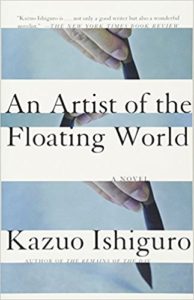An Artist of the Floating World
Kazuo Ishiguro
 It’s just after WWII and Masuji Ono, a celebrated painter, is in the middle of marriage negotiations for his daughter Noriko. The procedures disrupt his quiet retiree life full with gardening, making house repairs and drinking with old friends in the local pleasure district – now all but abandoned. To secure a positive outcome for his daughter, Masuji is forced to revisit his past – both figuratively and literally in the form of old acquaintances from before the war, and not all of this is as pleasant as he might have wished.
It’s just after WWII and Masuji Ono, a celebrated painter, is in the middle of marriage negotiations for his daughter Noriko. The procedures disrupt his quiet retiree life full with gardening, making house repairs and drinking with old friends in the local pleasure district – now all but abandoned. To secure a positive outcome for his daughter, Masuji is forced to revisit his past – both figuratively and literally in the form of old acquaintances from before the war, and not all of this is as pleasant as he might have wished.
We follow Masuji Ono from 1948 to 1950, in which Japan makes a rapid jump towards industrialisation, American style. While Masuji is more and more ready to accept responsibility for his past actions of glorifying the war through his art, it appears that the views of his surroundings take the opposite direction, as they are striving to let go of the past and look toward the future.
WWII is still a sensitive topic in Japan, and not readily talked about. Also in school, many parts of the war that are less than pretty are left out deliberately or are heavily censored and sanitised. I found Ishiguro’s view from the outside in – as an Englishman with Japanese roots – very interesting and enlightening.
Kazuo Ishiguro, born in Nagasaki in 1954, but living in England since age 5, has just been awarded the 2017 Nobel Prize for Literature. Even though he never lived in Japan, his books have definitely a Japanese feel to them, with his many allusions and implications that are directed at the insider. Many of his novels come with a shocking twist somewhere, that hit the reader – the outsider – with a harsh surprise.
Try out this – or other novels by Ishiguro – on amazon.com.
